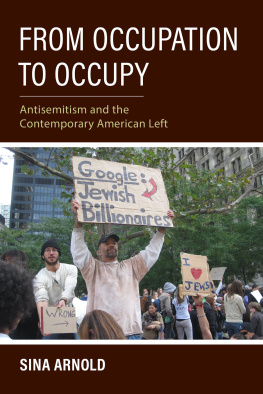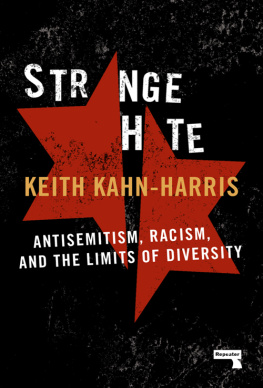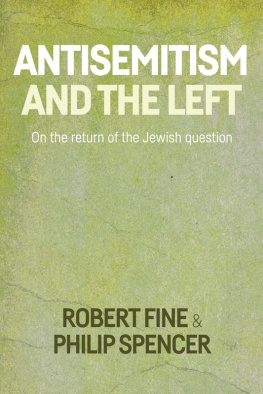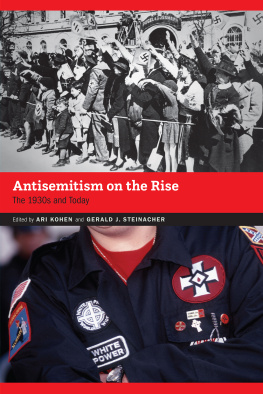Table of Contents
Guide
FROM OCCUPATION TO OCCUPY
STUDIES IN ANTISEMITISM
Alvin H. Rosenfeld, editor
FROM OCCUPATION TO OCCUPY
Antisemitism and the Contemporary American Left
Sina Arnold
Translated by Jacob Blumenfeld
INDIANA UNIVERSITY PRESS
This book is a publication of
Indiana University Press
Office of Scholarly Publishing
Herman B Wells Library 350
1320 East 10th Street
Bloomington, Indiana 47405 USA
iupress.org
Originally Published in German as: Das unsichtbare Vorurteil. Antisemitismusdiskurse in der US-amerikanischen Linken nach 9/11
2017 by Hamburger Editions HIS Verlagsges. mbH, Hamburg, Germany
This revised translation from German is published by arrangement with Hamburger Edition.
English Translation 2022 Indiana University Press
All rights reserved
No part of this book may be reproduced or utilized in any form or by any means, electronic or mechanical, including photocopying and recording, or by any information storage and retrieval system, without permission in writing from the publisher. The paper used in this publication meets the minimum requirements of the American National Standard for Information SciencesPermanence of Paper for Printed Library Materials, ANSI Z39.481992.
Manufactured in the United States of America
First printing 2022
The translation of this work was funded by Geisteswissenschaften InternationalTranslation Funding for Work in the Humanities and Social Sciences from Germany, a joint initiative of the Fritz Thyssen Foundation, the German Federal Foreign Office, the collecting society VG WORT and the Brsenverein des Deutschen Buchhandels (German Publishers & Booksellers Association).
Cataloging information is available from the Library of Congress.
ISBN 978-0-253-06312-0 (hardcover)
ISBN 978-0-253-06313-7 (paperback)
ISBN 978-0-253-06314-4 (e-book)
CONTENTS
A BOOK ABOUT A MOVEMENT CANNOT BE CREATED without a movement. Many people have contributed to this research over the years, some of whom I would like to name.
Friends and family, including Andrzej Profus, Anna Voigt, Blair Taylor, Brigitte Arnold, Carl Melchers, Dirk von Lowtzow, Doris Liebscher, Dorothea and Rainer Arnold, Gunnar Meyer, Hark Machnik, Jana Knig, Juni Aharon, Kolja Linder, Markus End, Momme Schwarz, Niko Baumann, Sarah Speck, Sebastian Bischoff, and Yvonne Wolz, who were there for discussions, feedback, and free time. More recently, Nikita Juli Arnold has slowed down the process of finishing this manuscript but sped up my heart in the most beautiful way imaginable.
Werner Bergmann and Eva-Maria Ziege provided me with professional support as my PhD supervisors. My international colleagues in the research network Ethnic Relations, Racism and Antisemitism of the European Sociological Association offered annual exchanges and much inspiration for critical antisemitism research, among them Philip Spencer, Gnther Jikeli, Christine Achinger and the late Robert Fine. Discussions with colleagues or comrades like Ilka Schrder, Kim Robin Stoller, Becka Tilsen, Robert Ogman, Spencer Sunshine, and Klaus Holz were also important for the development of this text over the yearsas were workshops with the Institute for Social Ecology and its members, like Peter Staudenmaier. My colleagues at the Center for Research on Antisemitism (ZfA) at Technische Universitt Berlin and the Berlin Institute for Empirical Research on Integration and Migration (BIM) at Humboldt-Universitt zu Berlin, especially Naika Foroutan, Uffa Jensen, and Stefanie Schler-Springorum, have always been incredibly supportive of my work.
Rainer Arnold, Carl Melchers, and Blair Taylor helped greatly in editing the original manuscript, as did Sabine Lammers at Hamburger Edition. I would also like to thank Paula Bradish and Jrgen Determann at Hamburger Edition for their firm support over the years. With Dee Mortensen, Ashante Thomas, Anna Francis, Nancy Lightfoot, and Gary Dunham, I was lucky to work with reliable and competent editors and publishers at Indiana University Press. David Lat provided me with his photo taken at the Occupy Wall Street protests for the books cover. And my sincere thanks also go out to Alvin Rosenfeld, who very much encouraged my publication.
The Friedrich-Ebert-Stiftung enabled my research in the first place through a doctoral funding scholarship. A grant from the Kantor Center for the Study of Contemporary European Jewry at Tel Aviv University helped in the final phase of the project. Funding from Geisteswissenschaften International finally made the translation possible. It was done by Jacob Blumenfeld, with whom I had a wonderful opportunity to work and whose linguistic and political insight helped in revising the manuscript substantially.
Three anonymous peer reviewers gave me valuable, varied, and very detailed feedback for the first version of the manuscript, which made it better and more precise.
And finally, many thanks to my interview partners, who gave me new perspectives on the history and present of the US Left.
This text is a thoroughly revised and substantially updated translation of the book Das unsichtbare Vorurteil. Antisemitismusdiskurse in der US-amerikanischen Linken nach 9/11, Verlag Hamburger Edition, Hamburg 2016.
The translation of this work was funded by Geisteswissenschaften InternationalTranslation Funding for Work in the Humanities and Social Sciences from Germany, a joint initiative of the Fritz Thyssen Foundation, the German Federal Foreign Office, the collecting society VG WORT and the Brsenverein des Deutschen Buchhandels (German Publishers & Booksellers Association). Additional funding for indexing was received from Hamburger Stiftung zur Frderung von Wissenschaft und Kultur.
Translated by Jacob Blumenfeld.
FROM OCCUPATION TO OCCUPY
F OR A LONG TIME, THE UNITED STATES SEEMED to be one of the few places in the world where antisemitism was no longer a serious threat. Of course, there were isolated incidents, but all in all, Jews had finally found a home in American society. In recent years, however, something has drastically changed. In 2017, Jewish cemeteries in St. Louis and Philadelphia were vandalized; in 2019, numerous assaults were carried out against Jewish people in New York City, while deadly shootings took place at a Poway synagogue and a kosher supermarket in Jersey City and a stabbing occurred at a Hanukkah party in Monsey. And, most deadly, the fatal attack on a Pittsburgh synagogue in 2018 in which eleven people lost their lives. All Jews must die, shouted the assassin, ranting about the extinction of the white race and hounding Muslims and migrants on the internet. His worldview reflects the deadly presence of the extreme Right in America today: in 2020, there were at least 838 right-wing hate groups in the United States.
This kind of overt antisemitism has also been encouraged by Donald Trumps presidency. When a participant of the rally killed a counterdemonstrator in Charlottesville, Trump proclaimed that there is blame on both sides.
Given this background, why focus on left-wing attitudes to antisemitism? On the one hand, left actors have also contributed to this dangerous discourse and thus to a feeling of insecurity among Jews in recent years. Be it the controversy surrounding the Womens March in 2017, in which Jewish women felt excluded and expressed concern about the courting of Louis Farrakhan, the leader of the Nation of Islam known for his antisemitic statements, Where do these attitudes come from? How do they relate to historical precursors, theoretical positions, and political strategy?
Next page











